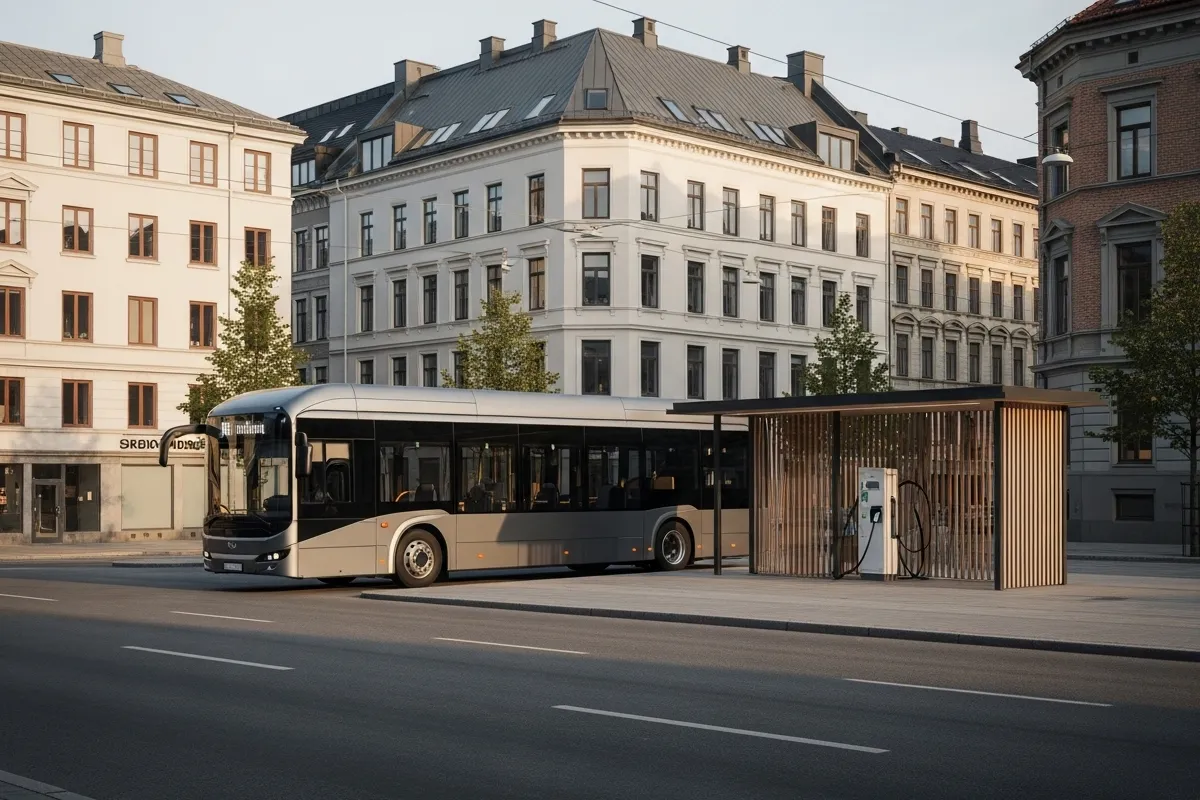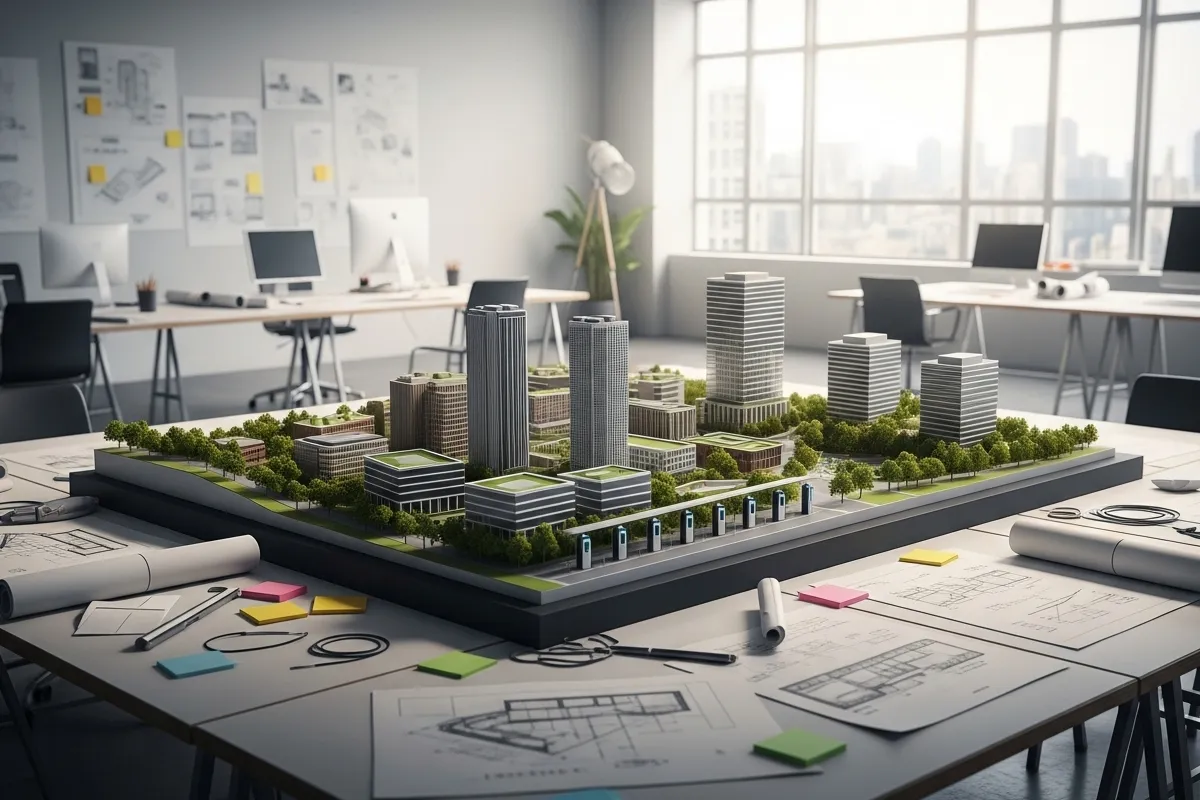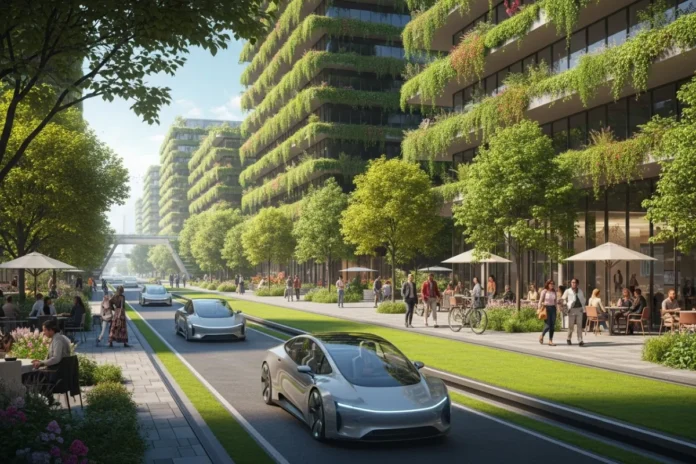Electric vehicles (EVs) have gained significant traction in recent years, representing a transformative shift not only in transportation methods but also in the design of urban environments. These vehicles are powered by electricity rather than traditional combustion engines, resulting in a notable decrease in greenhouse gas emissions and noise pollution. The increasing adoption of EVs aligns with global initiatives aimed at enhancing sustainability, improving local air quality, and fostering resilient urban communities.
The prevalence of urban noise pollution has been a growing concern, with studies indicating that it can lead to adverse health effects, including stress, sleep disturbances, and unknown long-term consequences. As cities continue to expand and populations increase, the demand for transportation has contributed to an uptick in vehicle-related noise. Electric vehicles present a solution to diminish this problem, as they operate much more quietly than their gasoline or diesel-powered counterparts, leading to a more serene street environment. This shift in noise levels has implications for urban design, as architects and city planners must evaluate how quiet streets can influence community interactions, open spaces, and overall urban aesthetics.
Moreover, the integration of EVs in urban planning goes beyond mere reduction in sound. It encourages the development of infrastructure that supports sustainable transportation options, such as charging stations and dedicated lanes for electric bike share systems. As cities begin to design around these principles, one can anticipate a more thorough reimagining of public spaces, which will prioritize pedestrian-friendly environments and promote eco-friendly commuting methods.
In consideration of the above factors, it is evident that the transition to electric vehicles will ultimately reshape the urban landscape, fostering quieter, cleaner, and more livable cities. Understanding the current state of urban noise pollution and the role of EVs in combating it sets the foundation for a broader discussion on the future of urban design.
The Psychological Impact of Reduced Noise Pollution
The transition to electric vehicles (EVs) presents a significant opportunity to enhance urban living by mitigating one of the most pervasive sources of noise pollution. Research highlights the crucial relationship between noise levels and mental health, with elevated noise believed to contribute to increased stress levels, anxiety disorders, and even long-term cognitive impairment. In urban settings, where traffic noise is a constant, the psychological toll can be profound, affecting residents’ overall well-being.
Noise pollution disrupts tranquil spaces and impairs the quality of daily life. Studies have illustrated that exposure to sustained noise can lead to sleep disturbances, which in turn exacerbate stress and hinder cognitive function. Moreover, individuals living in high-noise areas report lower levels of happiness and higher incidences of mental health issues. The advent of EV technology, known for its silent operation, offers a promising shift toward noise management in cities, potentially transforming them into more serene environments.
The psychological benefits of a quieter urban landscape extend beyond mere comfort; they can significantly enhance public health outcomes. When noise levels decrease, residents are typically more inclined toward outdoor activities and social interactions, vital components for mental health. By fostering environments that encourage engagement and well-being, we not only improve personal health but also contribute to community cohesion and collective happiness.
In essence, a reduction in noise pollution through the adoption of electric vehicles can foster environments where residents experience less stress and anxiety. As urban planners begin to embrace this shift, the cumulative effect may lead to a transformational change in how people perceive their surroundings, promoting healthier lifestyles for city dwellers and ultimately enhancing their quality of life. The anticipated benefits of quieter neighborhoods underscore the importance of integrating electric vehicles into future urban designs, aligning technological advancements with the mental health needs of residents.

Redesigning Public Spaces: Opportunities for Transformation
The advent of electric vehicles (EVs) presents a unique opportunity to fundamentally redesign public spaces throughout our cities. As urban areas transition from internal combustion engines to quieter, more eco-friendly transportation methods, we can rethink how parks, streets, and communal areas contribute to the quality of life. The reduction in noise pollution is just one aspect of creating more inviting, community-oriented environments where social interactions flourish.
Public squares and parks can be strategically redesigned to facilitate leisure activities and community engagement. For instance, with less noise from traffic, these areas can serve as multifunctional spaces that incorporate peaceful gardens, open-air cafés, and interactive installations. The introduction of greenery and natural aesthetics can further enhance the serene atmosphere, making these spaces more attractive to residents and visitors alike. In addition, integrating EV charging stations discreetly into the landscape can encourage more sustainable transportation while maintaining the visual integrity of the environment.
Moreover, the layout and accessibility of public spaces can be optimized to support various activities. For example, designing parks with designated areas for picnics, sports, and recreational activities can foster greater social interaction among community members. Implementing pedestrian-only zones within urban environments can prioritize walking, cycling, and socialization over vehicle traffic. These zones promote a sense of community and safety, inviting people to spend more time outside and engage with their surroundings.
Ultimately, the redesign of public spaces in a future defined by electric vehicles holds the promise of enhancing urban livability. By focusing on practicality, aesthetic appeal, and social connectivity, cities can create vibrant environments that not only accommodate the shift to electric transport but also enrich the lives of their residents.
The Future of Gas Stations: From Fueling Stations to Community Hubs
As the automotive landscape transitions towards electric vehicles (EVs), the traditional role of gas stations is set for a dramatic overhaul. With the growing prevalence of electric vehicles, the need for conventional fueling stations diminishes, thereby paving the way for innovative repurposing of these spaces. This evolution presents unique opportunities to transform gas stations into community hubs that foster social interaction and contribute positively to the urban environment.
One potential transformation includes converting gas stations into community centers. These spaces could serve as multifunctional areas where locals gather for events, workshops, and meetings. By integrating educational programs related to sustainable transportation and alternative energy sources, these centers could enhance public knowledge about electric vehicles and their benefits, promoting an eco-conscious community.
Moreover, gas stations can be repurposed into cafes or small retail outlets that cater to pedestrians and cyclists, offering a refreshing stop for refreshments and socialization. With dedicated spaces for pedestrians and outdoor seating, these venues can encourage a vibrant local economy while drawing people away from the automobile-centric mindset of traditional gas stations.
Additionally, the potential for green parks or recreational areas within these former fueling stations cannot be overlooked. Developing greenery not only contributes to improving urban biodiversity but also enhances the quality of life for residents. Green spaces provide much-needed relief from urban heat and create aesthetically pleasing environments that encourage outdoor activities, fostering healthy lifestyles and community bonds.
In essence, the transition from traditional gas stations to community hubs aligns with the broader goal of developing cities that prioritize sustainability, inclusivity, and community engagement. As the adoption of electric vehicles continues to rise, it is imperative that stakeholders consider these evolving roles seriously, paving the way for more interconnected neighborhoods. This transformation stands to strengthen community ties, making our urban spaces not just functional but also integral to the social fabric they host.

Case Study: Oslo, Norway – A Model for Quiet Cities
Oslo, the capital of Norway, has emerged as a prominent example of a city proactively working to mitigate noise pollution through the integration of electric vehicles (EVs) into its urban infrastructure. Over recent years, city planners have implemented a series of strategic initiatives aimed at creating a quieter, more sustainable environment for its residents. One of the foremost steps was the promotion and adoption of electric taxis and buses. This shift has significantly reduced the noise levels traditionally generated by their combustion-engine counterparts, contributing to a more serene urban landscape.
Oslo’s commitment to fostering a cleaner city is further underscored by its extensive network of charging stations, making it increasingly convenient for residents to switch to electric vehicles. The city’s focus on sustainability extends beyond merely encouraging the use of EVs; it also encompasses incentivizing the use of bicycles and public transport. Programs aimed at improving cyclist safety and integrating bike lanes into the overall city planning have resulted in a noticeable reduction in vehicle traffic, thereby also decreasing noise pollution. Some studies have shown that areas outfitted with dedicated bicycle paths report a marked improvement in sound quality, resulting in enhanced community well-being.
Furthermore, Oslo has invested in creating quiet zones within its urban spaces. These areas are designated for pedestrians and cyclists and are enforced with restrictions on conventional vehicle traffic, further promoting tranquillity. The implications of these efforts are observable not just in reduced noise levels but also in heightened community engagement and interaction. Residents report a greater quality of life and a sense of ownership over their neighborhoods as spaces become more suited for communal activities rather than dominated by vehicular noise.
In summary, Oslo serves as a valuable case study in demonstrating the potential of electric vehicles and urban design strategies to foster quieter, more engaging communities. By prioritizing sustainable practices, the city is paving the way for future urban transformations. Through ongoing innovations and community participation, Oslo provides a blueprint for cities worldwide seeking to improve urban life, contribute to environmental health, and champion community engagement.
Challenges to Implementing Quiet Cities
The transition from traditional urban environments to quieter cities, facilitated by the integration of electric vehicles (EVs), presents numerous challenges that must be addressed to ensure successful implementation. One significant obstacle lies in the necessity for extensive infrastructure updates. Existing roadways, charging stations, and public transport systems often require modifications or complete overhauls to accommodate the adoption of EVs, which can be both time-consuming and costly. Infrastructure improvements are essential to support the efficient operation of electric vehicles, but they often encounter bureaucratic red tape and require navigating complex urban planning processes.
Resistance from various stakeholders also poses a considerable challenge. Local businesses, vehicle manufacturers, and even residents may be hesitant to embrace the shift to quieter streets due to concerns about increased taxes, disruptions during construction, or a perceived threat to their livelihood. Public perception of electric vehicles and the overall concept of quiet cities can vary significantly, leading to dissent among community members. Educating these stakeholders about the long-term benefits of quieter urban environments is crucial for garnering support and facilitating a smoother transition.
Furthermore, financial implications cannot be overlooked. The initial costs associated with transitioning to electric vehicles, investing in new infrastructure, and providing necessary incentives for adoption can strain municipal budgets. High upfront costs might deter city planners from pursuing these projects, even when the long-term advantages seem promising. Cities need to develop comprehensive financial strategies that include public-private partnerships, grants, and other funding mechanisms to address the economic challenges posed by this transition effectively. By navigating these hurdles, local governments and communities can create tranquil urban landscapes that promote well-being and sustainability.

Strategies for Community Involvement and Engagement
Creating effective urban spaces in the era of electric vehicles necessitates active community involvement and engagement. Ensuring that residents have a voice in the planning process is crucial to meeting their needs and desires. One effective strategy is the organization of community workshops, designed to gather input and foster dialogue among residents. These workshops should provide a platform for residents to express their vision for their neighborhoods, discuss potential changes, and explore how electric vehicles can reshape their environments into quieter spaces.
Feedback sessions represent another essential strategy to gauge community sentiment successfully. By systematically soliciting opinions through surveys or town hall meetings, city planners can capture a wide array of perspectives. These sessions can help identify key concerns or ideas related to the integration of electric vehicles in urban design, ensuring that all voices are heard. Consequently, incorporating this feedback into the planning process can enhance community buy-in and satisfaction with the resulting designs.
Furthermore, engaging residents in collaborative design processes can effectively translate their visions into tangible plans. Involving community members in design charrettes, where they can work alongside urban planners, architects, and engineers, allows for a shared sense of ownership over the projects. Such engagement fosters creativity and innovation, drawing from diverse insights that reflect the unique character of each neighborhood. By utilizing these strategies, cities can create more inclusive environments that not only accommodate electric vehicles but also embrace the broader community’s aspirations for quieter, cleaner, and more vibrant urban spaces.
The Role of Policy in Shaping Quiet City Futures
As cities advance towards integrating electric vehicles (EVs) into their urban landscapes, the establishment of effective policies plays a pivotal role in achieving quieter and more sustainable urban environments. Local governments are uniquely positioned to set legislative frameworks that not only support the adoption of electric vehicles but also promote noise reduction initiatives and sustainable urban planning. The alignment of these policies with the adoption of EVs can significantly contribute to reducing overall noise pollution and enhancing the quality of urban life.
One of the foremost strategies for local governments is to incentivize both consumers and businesses to transition to electric vehicles. This can be achieved through financial incentives such as tax rebates, grants, and subsidies that lower the initial cost of EVs. Additionally, providing subsidies for charging infrastructure development encourages investment in charging stations, making it more convenient for residents to charge their vehicles while simultaneously reducing potential noise from traditional combustion engine vehicles.
Incorporating noise reduction initiatives within urban development policies is crucial as well. Local governments can promote zoning laws that prioritize quiet zones, particularly in residential areas and near schools and hospitals. Such policies may include restrictions on the use of high-noise machinery or regulations limiting vehicular access in certain districts. Furthermore, urban planning can facilitate the creation of EV-friendly environments by emphasizing dedicated lanes for electric vehicles and pedestrian pathways that reduce reliance on traditional vehicles, thereby mitigating noise.
Ultimately, the collaboration between policymakers, urban planners, and the community is essential for fostering a comprehensive strategy that embraces the transformational potential of electric vehicles. By establishing a coherent legislative environment that supports noise reduction and sustainable practices, cities can foster a quieter, more vibrant future, promoting a higher quality of life for all residents.
Conclusion: Envisioning the Future of Urban Living
The transition to electric vehicles (EVs) marks a pivotal moment in the evolution of urban living. As cities around the world adapt to this innovative technology, they foster an environment that prioritizes sustainability, safety, and enhanced quality of life. The substantial reduction in noise pollution brought about by electric vehicles signifies a shift towards quieter neighborhoods, contributing to public health and well-being. Moreover, as citizens experience the direct benefits of quieter streets, there is potential for greater community engagement and a heightened sense of connection to their surroundings.
The integration of electric vehicles into urban infrastructures presents numerous opportunities for reimagining city layouts. With the reduction of harmful emissions and a decreased reliance on fossil fuels, cities can evolve into greener spaces that offer improved air quality and healthier living conditions for their inhabitants. Transportation networks can become more efficient and user-friendly, encouraging public transit use, cycling, and walking. This interconnectedness may lead to a renaissance in urban design, where parks, greenways, and pedestrian-friendly zones become integral components of the urban fabric.
Additionally, the shift towards electric mobility has broader implications for environmental stewardship and climate action. As the world grapples with the impact of climate change, the adoption of electric vehicles can serve as a critical strategy in carbon reduction. As cities redefine their transportation systems to prioritize electric mobility, they also position themselves as leaders in innovation and sustainability, setting a precedent for others to follow.
Ultimately, envisioning the future of urban living involves imagining a world where electric vehicles not only redefine how we navigate our communities but also enhance the interconnectedness of society. By advocating for this transformation, we can collectively work towards vibrant, livable cities, characterized by serenity, sustainability, and strengthened community bonds.




